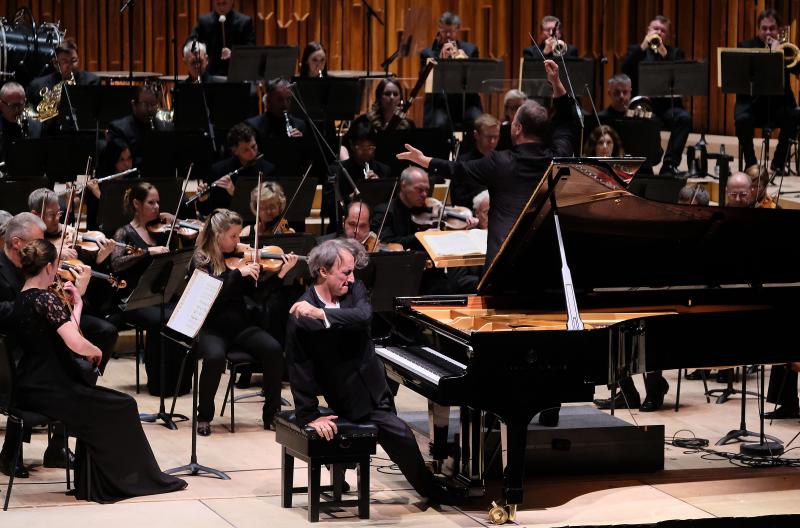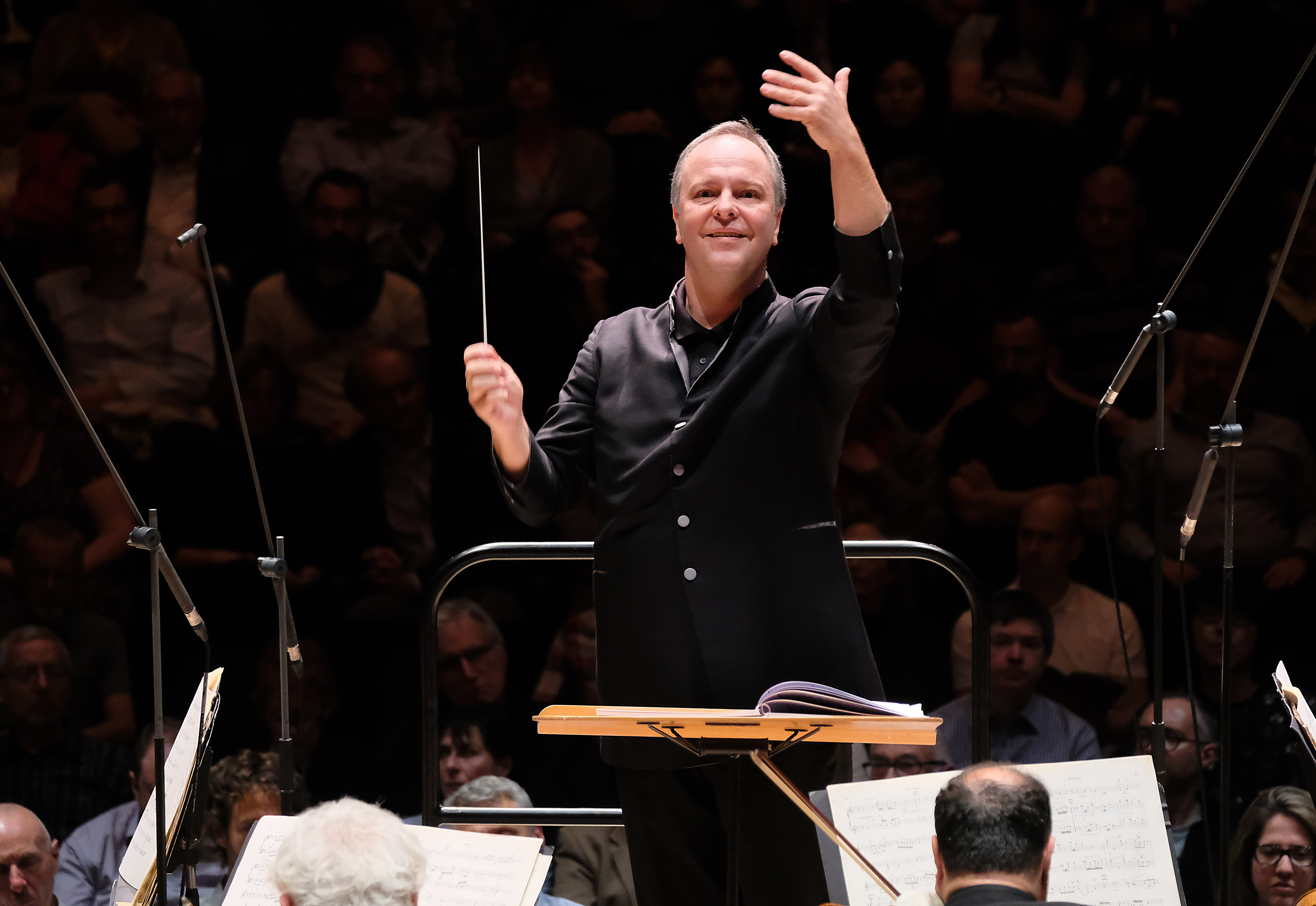Bavouzet, BBCSO, Oramo, Barbican review - playing the long game in Sibelius | reviews, news & interviews
Bavouzet, BBCSO, Oramo, Barbican review - playing the long game in Sibelius
Bavouzet, BBCSO, Oramo, Barbican review - playing the long game in Sibelius
Purpose and restraint pay off in contrasting three-movement symphonies

Perhaps Sibelius did the right thing, signing off Tapiola in 1926 and then all but closing his account, spending the next three decades sitting and drinking.
Dating from the year before his death in 1958, the Second Symphony is Schmitt’s last major work. It's cast like Sibelius’s Third in three movements, but there the resemblance ends. Schmitt tears up the symphonic rulebook and leaves the pieces to rain down like fluorescent confetti. With the experience last year of performing Schmitt’s over-ripe incidental music for Antony and Cleopatra, Sakari Oramo and the BBC Symphony Orchestra have this busy, tricksy idiom under their belts.
Oramo dug out the symphony's opening with vernal promise and determination
Their performance was a model of clarity and breezily good-natured character compared with the only commercial recording, but the symphony itself – maybe even the title is a wind-up? Schmitt didn’t write a First – is like a film-set full of actors milling around, waiting for a director to give them something to do. Vibraphone smoke drifts off a viola Gauloises. The second movement is capped with a muted trumpet, just in case the image of Belmondo fixing the middle distance with resolute ennui wasn’t already lodged in the mind’s eye.
Jean-Efflam Bavouzet reversed that strain of expression with an air of relaxed purpose in the Symphonic Variations of César Franck. Space and gesture were judged as finely from the outset as any Truffaut tracking shot to establish a contention between soloist and orchestra, expanding on the Orpheus-and-the-Furies model established by Beethoven in the Largo of the Fourth Concerto. Bavouzet drew from the lower reaches of the house Steinway an unusually open, speaking tone. If heroic assertion was missing, he supplied it with a vengeance after the interval, imperiously dismissing a rather prosaic orchestral introduction to the Left-Hand Concerto of Ravel with a cadenza of unperturbed defiance. The BBCSO latched on, punching out the invasion of jazz – Le sacre meets Fats Waller – with a malign show of force. Bassoonist Amy Harman really swung her solo and Oramo directed the episode with the relish for calculated anarchy that also belongs to the concerto’s slightly older sister, Boléro. The conductor (pictured above) had made an outstanding debut with this orchestra, now his orchestra, in 2011. Sibelius 3 was the clincher that evening and they returned to it last night. Once training and study have drawn the outline of a piece in a conductor’s head, it tends to hold its shape over the years, allowing for the vagaries of available time and willing colleagues. Only very good, very bad or very old conductors start excavating the foundations or knocking down the supporting walls of their interpretations. More than other composers, Sibelius encourages an attitude of gradual evolution in coming to terms with his music, perhaps because that’s the way his own music behaves.
The conductor (pictured above) had made an outstanding debut with this orchestra, now his orchestra, in 2011. Sibelius 3 was the clincher that evening and they returned to it last night. Once training and study have drawn the outline of a piece in a conductor’s head, it tends to hold its shape over the years, allowing for the vagaries of available time and willing colleagues. Only very good, very bad or very old conductors start excavating the foundations or knocking down the supporting walls of their interpretations. More than other composers, Sibelius encourages an attitude of gradual evolution in coming to terms with his music, perhaps because that’s the way his own music behaves.
Even more than the Seventh, the Third describes just such a process of coming to be, and on this occasion Oramo dug out its opening with vernal promise and determination, squarely out of joint with the season, throwing forward the symphony’s keystone to the middle movement which is too often treated as an enigmatic intermezzo. Paired flutes and clarinets were perfectly in tune both with each other and with the conductor’s vision of the piece, dwelling time and again on the last phrase of a sad little song that haunts the memory of the music itself, daring to leave a few more expressive wires bare and loose than in 2011. Sibelius plays tricks with time and space like no other composer, and Oramo brought the overlapping layers of the finale to a close of irresistible satisfaction.
The future of Arts Journalism
You can stop theartsdesk.com closing!
We urgently need financing to survive. Our fundraising drive has thus far raised £49,000 but we need to reach £100,000 or we will be forced to close. Please contribute here: https://gofund.me/c3f6033d
And if you can forward this information to anyone who might assist, we’d be grateful.

Subscribe to theartsdesk.com
Thank you for continuing to read our work on theartsdesk.com. For unlimited access to every article in its entirety, including our archive of more than 15,000 pieces, we're asking for £5 per month or £40 per year. We feel it's a very good deal, and hope you do too.
To take a subscription now simply click here.
And if you're looking for that extra gift for a friend or family member, why not treat them to a theartsdesk.com gift subscription?
more Classical music
 Echo Vocal Ensemble, Latto, Union Chapel review - eclectic choral programme garlanded with dance
Beautiful singing at the heart of an imaginative and stylistically varied concert
Echo Vocal Ensemble, Latto, Union Chapel review - eclectic choral programme garlanded with dance
Beautiful singing at the heart of an imaginative and stylistically varied concert
 Scott, Irish Baroque Orchestra, Whelan, RIAM, Dublin review - towards a Mozart masterpiece
Characteristic joy and enlightenment from this team, but a valveless horn brings problems
Scott, Irish Baroque Orchestra, Whelan, RIAM, Dublin review - towards a Mozart masterpiece
Characteristic joy and enlightenment from this team, but a valveless horn brings problems
 Classical CDs: Voice flutes, flugelhorns and froth
Baroque sonatas, English orchestral music and an emotionally-charged vocal recital
Classical CDs: Voice flutes, flugelhorns and froth
Baroque sonatas, English orchestral music and an emotionally-charged vocal recital
 Kanneh-Mason, Britten Sinfonia, Shave, Milton Court - a grin and a big beaming smile
A pair of striking contemporary pieces alongside two old favourites
Kanneh-Mason, Britten Sinfonia, Shave, Milton Court - a grin and a big beaming smile
A pair of striking contemporary pieces alongside two old favourites
 theartsdesk at the New Ross Piano Festival - Finghin Collins’ musical rainbow
From revelatory Bach played with astounding maturity by a 22 year old to four-hand jazz
theartsdesk at the New Ross Piano Festival - Finghin Collins’ musical rainbow
From revelatory Bach played with astounding maturity by a 22 year old to four-hand jazz
 First Person: Manchester Camerata's Head of Artistic Planning Clara Marshall Cawley on questioning the status quo
Five days of free events with all sorts of audiences around Manchester starts tomorrow
First Person: Manchester Camerata's Head of Artistic Planning Clara Marshall Cawley on questioning the status quo
Five days of free events with all sorts of audiences around Manchester starts tomorrow
 Goldscheider, Brother Tree Sound, Kings Place review - music of hope from a young composer
Unusual combination of horn, strings and electronics makes for some intriguing listening
Goldscheider, Brother Tree Sound, Kings Place review - music of hope from a young composer
Unusual combination of horn, strings and electronics makes for some intriguing listening
 theartsdesk Q&A: composer Donghoon Shin on his new concerto for pianist Seong-Jin Cho
Classical music makes its debut at London's K-Music Festival
theartsdesk Q&A: composer Donghoon Shin on his new concerto for pianist Seong-Jin Cho
Classical music makes its debut at London's K-Music Festival
 Helleur-Simcock, Hallé, Wong, Bridgewater Hall, Manchester review - moving lyricism in Elgar’s concerto
Season opener brings lyrical beauty, crisp confidence and a proper Romantic wallow
Helleur-Simcock, Hallé, Wong, Bridgewater Hall, Manchester review - moving lyricism in Elgar’s concerto
Season opener brings lyrical beauty, crisp confidence and a proper Romantic wallow
 Kohout, Spence, Braun, Manchester Camerata, Huth, RNCM, Manchester review - joy, insight, imagination and unanimity
Celebration of the past with stars of the future at the Royal Northern College
Kohout, Spence, Braun, Manchester Camerata, Huth, RNCM, Manchester review - joy, insight, imagination and unanimity
Celebration of the past with stars of the future at the Royal Northern College

Add comment